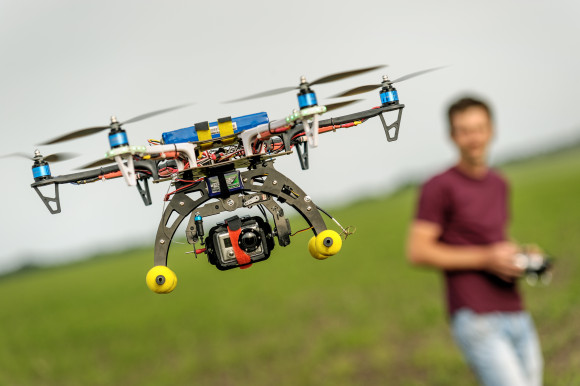The father and son who posted videos of drones firing a handgun and incinerating a Thanksgiving turkey with a flame-thrower can be questioned by aviation regulators, a U.S. judge ruled in a closely watched case that may determine the government’s ability to oversee unmanned aircraft.
The FAA is investigating whether the flights — which became an internet phenomenon on YouTube — may have violated aviation safety regulations.
U.S. District Court Judge Jeffrey Meyer dismissed the arguments of Austin and Bret Haughwout, who maintained that the Federal Aviation Administration had no legal authority over the small drones because they aren’t aircraft and the agency has no right to question them.
“I do not agree,” Meyer wrote in a decision issued on Monday. The judge said “it is plausible to believe that the Haughwouts’ devices fall within the definition of an ‘aircraft’ for the purposes of federal law.”
Whether the FAA will be able to successfully bring an enforcement case against the pair from Clinton, Connecticut, is a separate matter, the judge said. He laid out the eventual arguments in what may become a test case over the limits of the FAA’s authority over drones. The FAA argues that it controls the airspace down to the ground for purposes of overseeing drones, but Meyer questioned whether that is legitimate.
Authority Questioned
“No clause in the Constitution vests the federal government with a general police power over all of the air or all objects that leave the ground,” he wrote. He stopped short of issuing an opinion on that, saying: “This case does not yet require an answer to that question.”
The debate over where FAA’s authority begins and ends holds enormous potential impact over the burgeoning drone industry, said Rebecca Byers MacPherson, a lawyer at Jones Day in Washington who formerly worked as an FAA attorney.
The FAA has traditionally avoided regulating aircraft below 200 feet because airplanes and helicopters rarely fly that low except at airports, MacPherson said. Drones, which fly in those near-ground zones, have led the FAA to claim authority closer to the ground.
Industry Impact
How the courts eventually decide that question will impact numerous industries, such as railroads and utilities that may not want unmanned aircraft hovering over their property, as well as individuals like the Haughwouts or neighbors who may fear for their privacy, she said.
Austin Haughwout, who had been a student at a local state college, created a sensation with his drone videos, first posting one last year of a quad-copter holding a black handgun apparently firing shots into a wooded area. It has been viewed more than 3.7 million times. Later last year, he posted a separate video entitled “Roasting the Holiday Turkey” showing a slightly larger drone holding a flame-thrower blasting a turkey on a spit.
The Haughwouts’ attorney, Mario Cerame, did not immediately return a phone call seeking comment. Cerame has argued that the FAA is overreaching in its investigation.
“You’ve got to stop for a second and think about what’s the jurisdiction of the FAA,” he told reporters after a July 6 hearing on the case in New Haven according to video posted by the Hartford Courant. “What do they have power over? Do they have power over what people do in their backyards on their own property? No one is saying anyone was hurt here.”
The case is Huerta v. Haughwout, 16-cv-00358, U.S. District Court, District of Connecticut (New Haven).
Was this article valuable?
Here are more articles you may enjoy.



 Investors Are Increasingly Interested in a Novel Type of Weather Insurance
Investors Are Increasingly Interested in a Novel Type of Weather Insurance  Insurer Chubb Readies $350M Payout Tied to Baltimore Bridge Collapse
Insurer Chubb Readies $350M Payout Tied to Baltimore Bridge Collapse  ‘Dirty Dozen’ Unsafe Employers Putting Workers at Risk
‘Dirty Dozen’ Unsafe Employers Putting Workers at Risk  London Firms Are Letting More Staff Work Entirely From Home
London Firms Are Letting More Staff Work Entirely From Home 

